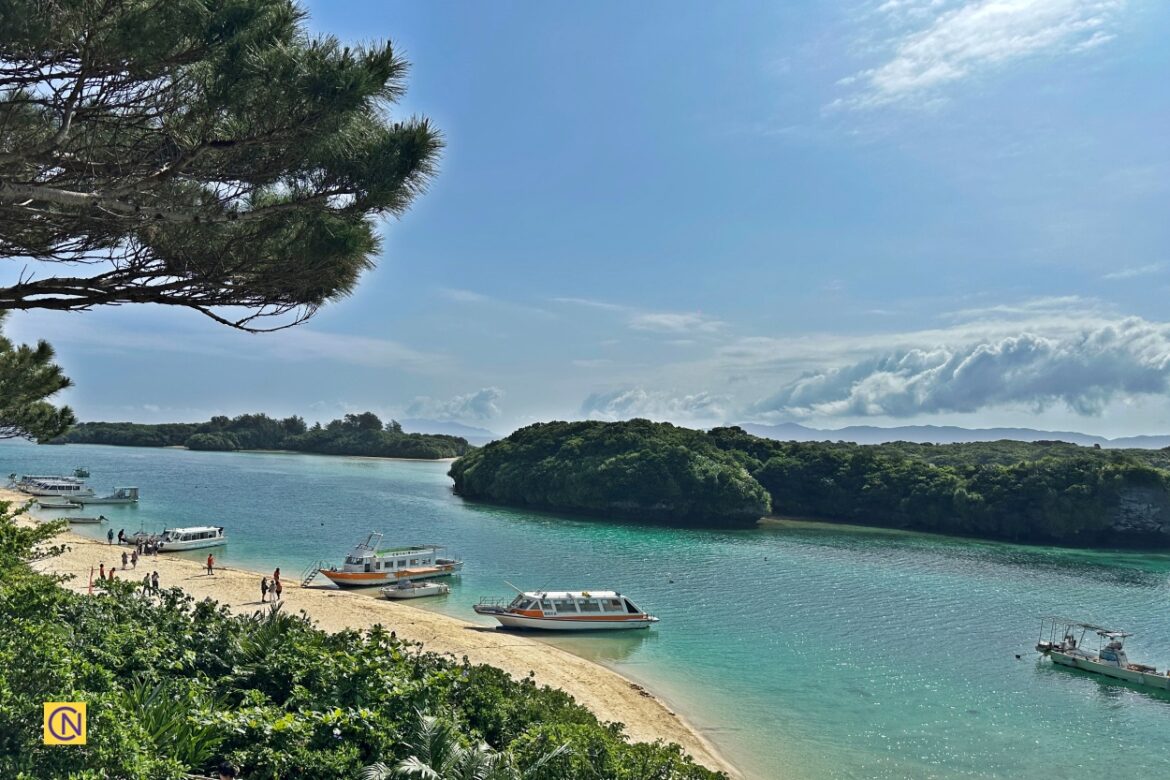Located on the northwestern shore of Ishigaki Island (石垣島) in Japan’s Okinawa Prefecture, Kabira Bay (川平灣) enchants visitors with its vivid turquoise waters, pristine white sands, and lush tropical landscapes. Celebrated as one of Japan’s top 100 scenic spots, the bay offers breathtaking natural beauty and a rich cultural heritage, providing a harmonious blend of nature and tradition.

Ishigaki Island lies approximately 270 kilometers (168 miles) from the northeastern coast of Taiwan, significantly closer than Tokyo, which is about 1,950 kilometers (1,212 miles) away. Due to this proximity, the island has become one of the popular cruise destinations for Taiwanese travelers seeking an accessible and scenic getaway. Beyond Kabira Bay, Ishigaki is also home to other stunning coastal landmarks, such as Uganzaki Cape and its iconic lighthouse, offering dramatic views and unforgettable sunsets.
A glimpse into the history of Kabira Bay
As part of Iriomote-Ishigaki National Park, Kabira Bay is renowned for its natural beauty and deep historical significance. Dating back to the era of the Ryukyu Kingdom (1429-1879), the bay played a vital role as a maritime hub for trade and cultural exchange. Wooden trading vessels known as “Maransen” often anchored here, using the sheltered waters as a stopover while waiting for favorable winds to transport goods to the Ryukyuan royal court. Its strategic location also made it an essential point of contact between Japan, China, and other parts of Asia, fostering centuries of cross-cultural interaction.

Kabira Bay’s historical relevance extended into the modern era as well. During World War II, the bay served as a base for kamikaze boats — small, explosive-laden motorboats used in suicide missions — marking a darker chapter in its otherwise tranquil history.

Today, echoes of this rich past are still evident in the local culture, architecture, and customs. Visitors can explore nearby historic landmarks, learn about traditional maritime practices, and gain insight into the legacy of the Ryukyu Kingdom, whose influence continues to shape the identity of Ishigaki Island.
Unrivaled scenic beauty of Kabira Bay
Beyond its historical significance, Kabira Bay is renowned for its stunning scenery and serene atmosphere, making it a popular destination for relaxation, sightseeing, and photography. A particular highlight for many travellers is the 30-minute glass-bottom boat cruise, which provides an opportunity to glimpse the bay’s vibrant underwater ecosystem, including sea turtles, without getting wet. Combining crystal-clear waters, unique reefs, and picture-perfect landscapes ensures an unforgettable experience.

In 2009, Kabira Bay was awarded the prestigious three-star rating by the Michelin Green Guide Japan, making it one of only 17 places in Japan to receive this honor. In addition to this accolade, it is officially designated as a national scenic spot and is part of a special preservation zone within the national park. As evening approaches, the bay is bathed in warm, golden light, transforming the landscape into a tranquil, picture-perfect scene — an unforgettable conclusion to a day enriched by natural splendor and historical significance.
Located beside the picturesque shoreline, Kabira Park offers a welcoming space with well-kept walking paths, picnic spots, and scenic overlooks that provide breathtaking views of the bay and its lush surroundings. It’s an ideal destination for families, nature enthusiasts, and casual visitors looking to enjoy a relaxing day immersed in the area’s natural beauty.

One of Kabira Park’s standout features is its observatory, which offers visitors sweeping views of the bay, shimmering coastal waters, and the lush surrounding landscape. Guests can take in the breathtaking scenery from this vantage point and capture unforgettable photographs. The park is also home to many local flora and fauna, making it ideal for leisurely nature walks and birdwatchers.
The legacy of black pearl cultivation in Kabira Bay
One of Kabira Bay’s distinctive features is its black pearl cultivation industry, which benefits from its pristine waters and ideal natural conditions. These rare, lustrous pearls are highly prized for their unique beauty and are vital to the region’s identity. Kabira Bay is recognised as one of the first places in the world to cultivate black pearls successfully. This pioneering achievement has enhanced its international reputation and enriched its cultural heritage.

Visitors can explore this fascinating tradition by visiting local shops and exhibitions that offer a behind-the-scenes look at pearl cultivation. In addition to showcasing exquisite handcrafted jewellery, these venues highlight the historical and cultural significance of black pearls in the community, providing a meaningful experience for those interested in the island’s heritage and craftsmanship.

Uganzaki Lighthouse and Uganzaki Cape
Uganzaki Lighthouse (御神崎燈台) is approximately 15 kilometers (9.3 miles) away from Kabira Bay. It is located on the rugged cliffs of Uganzaki Cape (御神崎), the westernmost point of Ishigaki Island in Okinawa. Built in 1975, this iconic lighthouse is a navigational beacon guiding ships safely and offers panoramic views of the East China Sea and the surrounding coastline.

Uganzaki Cape is renowned for its dramatic scenery, cliffs, and vibrant marine life. It is a breathtaking coastal gem famous for its stunning, rugged cliffs and dramatic rock formations that rise sharply from the ocean’s turquoise waters. The jagged coastline creates a mesmerizing landscape that is both serene and awe-inspiring.

Visitors to Uganzaki Cape are greeted by panoramic views stretching far across the horizon, particularly at sunset when the cliffs are bathed in a warm golden glow. Another notable feature is the statue of Guanyin Bodhisattva, which was erected next to the lighthouse in memory of the Chinese merchant ship crew who perished in a shipwreck many years ago.
Follow us on X, Facebook, or Pinterest

